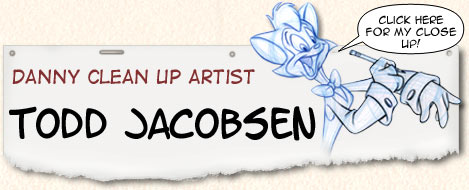
It’s another year gone by and time to add yet another ‘Cat Chat’. This interview’s honoree is animator , clean up artist and totally nice guy, Todd Jacobsen. Take it away, Todd!
How did you get into animation and what were your inspirations?
Well, I came to the party in a rather long, late and roundabout way. As a kid I'd always been interested in animation and cartooning. I was almost rabid about it, actually. The only problem was that where and when I grew up, in rural Idaho in the 1960's and early-1970's, there weren't that many opportunities to pursue my passion. So fortunately my parents took my brothers and I to see the Disney re-releases whenever they came to the one movie theater in a neighboring town a half-hour away. I copied characters from the old "Peanuts" and "Pogo" books my parents collected, and drew from memory the stuff I saw on TV like the old Warner Bros. and MGM shorts, and "The Wonderful World of Disney." I bought Preston Blair's "Animation" book with money I'd saved from doing odd jobs, and copied all the pages on whatever scraps of paper were laying about. I didn't have the equipment to make any animation of my own, but borrowed and read books from my school library on how it was done.
Then my teenage years intervened. I was still somewhat interested in cartooning and caricature, copying Al Hirschfeld's drawings and the stuff I saw in MAD Magazine, particularly Mort Drucker's work. But because what I saw on Saturday morning cartoons at that time didn't appeal to me at all, and feeling there was nothing new animation-wise to inspire me, I shifted my attention to performing music. (I had begun piano lessons when I was five, and picked up the basics of a few other instruments like drums, guitar and brass through my school district's band programs.)
I moved to Southern California with my mother when I was sixteen. Two years later when I was ready to graduate high school being a starving musician didn't seem like such a grand idea either, so I studied accounting and worked as a bookkeeper to put myself through college. Although I was pretty good at it, after four or five years I started to realize I wasn't all that thrilled at the prospect of doing it for the rest of my life. So I shifted focus and went to Cal State Northridge to study graphic design with the intent of getting a job in advertising. I was walking back to my apartment through campus one night, and I just happened to see a flier for a traveling movie show that was playing in the University auditorium. It featured some currently produced animation shorts from all over the world, so I bought a ticket, went in late, and as I was sitting there watching all this great stuff it was like some key was unlocking a long-shut door in my head: "This is what you've always wanted to do."
I hunkered down in the school's library and started to reread all the books I'd read when I was young on how to animate, and I borrowed some equipment from the University's Radio, TV and Film department (CSUN didn't have an animation program back in the late 1980's) and made a quick, one-minute stop-motion short in my bedroom with a Super-8 camera that was timed to some music. During this time, I also enrolled in a couple of inexpensive classes in hand-drawn assistant animation at the Animator's Union that were being taught by a man named Dale Oliver. There were only three or four people in the class, but he seemed to take a very strong interest in me and my work, giving me different assignments than what he gave the others.
It wasn't until a few years later, after he and I parted company, that I found out he was an assistant to Frank Thomas, one of Disney's Nine Old Men. This came as a total shock to me, as Dale had never mentioned this and at the time, I was too much of a "student" to even think about approaching him or his past like that. He was an extremely kind, quiet and humble man, and the information I gained from him was far beyond anything I'd ever read in any book on animation. I consider myself very fortunate to have studied with him.
By that time, I was tired of having to split my time between work and school. I really wanted to work on commercials, so I took my short film and all my graphic design exercises and life drawings to two small studios in Los Angeles that I found in some industry directories. The first one, Kurtz and Friends, didn't have any work at the time but the woman who looked at my portfolio told me my stuff was fairly good and not to give up. The second one was Klasky-Csupo, and I discovered when I got there they had just started pre-production on "The Simpsons" TV series. They hired me as a production assistant to work on the show, which meant I operated the copy machine, packed boxes and ran out to get donuts and coffee. I eventually started keeping track of scenes as they passed through their paces, and it was on the first 22 episodes of the series that I began my "formal" animation training. Talk about your lucky breaks.
This was in the early summer of 1989, and it wasn't until 1993 (and three other projects later) that I started drawing full-time. I'm really grateful I had those experiences on the production side first; making myself familiar as to the requirements and unique characteristics of each department in the animation process made the transition into drawing for production a lot easier. And whenever somebody who is interested in getting in the business asks me where they should start, I always suggest trying to get an entry-level production position. For me, there were a lot of things that I experienced in a real-world setting that I couldn't possibly have learned in school or in books.
How did you come to join the 'Cats Don't Dance' crew at Turner Features?
I was working as an assistant director on the second season of "The Ren & Stimpy Show" when I first heard about "Cats Don't Dance." What really excited me was the style of the film: kind of a wild, bouncy, Bob Clampett and Chuck Jones-like cartoon with a thick and thin, Al Hirschfeld-esque cleanup line. I had had my first cleanup job on a film called "Bebe's Kids" a year earlier that employed the same line style, so I figured I might be a good fit. I knew a guy who was working at Turner that I'd met while working on "FernGully: The Last Rainforest" a couple years earlier, and feeling like it was time to start drawing instead of just keeping track of scenes, I called him up and he managed to get me a spot as a cleanup inbetweener on "The Pagemaster," the film before "CDD."
Which character crew did you work on and what were your instructions on handling them?
I started out working on the Darla Dimple crew as a cleanup breakdown artist. (My desk was right across the hall from Frans Vischer and Jay Jackson's offices, so I got to know both of them very well and remain friends to this day.) One day I asked Frans if he could show me the ropes of rough animation, so he gave me a scene to practice on after hours. This was the scene where Darla is flooding the "Lil' Ark Angel" stage and says to Max, "More water...more water!" Frans was very patient with me; at one point I became so frustrated with my inabilities I gave it back to him to have someone else finish it! But after much tearing of hair, gnashing of teeth and many of Frans' encouragements and corrections (and there were many corrections!), the scene was approved and sent on to cleanup. I'm glad it made the final cut of the film.
It wasn't much later that the demands of the Danny crew were such that another cleanup assistant position was needed, so I got a promotion and started working with Jay and Bob Scott, the other supervising animator on Danny. I received a great piece of advice from Bob regarding his scenes that I'd never heard before: "I expect your drawings to look as good if not better than my drawings, so please, just make sure that the entire scene leaves your desk looking better than it did when it arrived." I thought that was the best instruction for cleaning up a scene I could ever have received, and I truly believe that it was the reason I got promoted to a key assistant position a short time later. I still use that tip today, regardless of my position on an animation crew. (Thanks, Bob!)
I found that Jay's and Bob's styles both complimented Danny's personality. Jay was excellent at finding the tiniest subtleties in Scott Bakula's vocal performances and creating really appealing poses for them, stuff that makes the audience relate to Danny on a deep, emotional level. Bob is a master at pushing animation's boundaries, much like Ward Kimball (another one of Disney's Nine 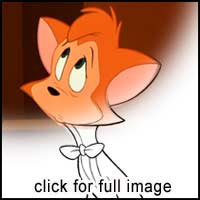 Old Men), and his cartoon-y character design is unparalleled, so those elements lent themselves to helping create Danny's enthusiasm and confidence through the use of angular, graphic shapes that attract the viewer's eye.
Old Men), and his cartoon-y character design is unparalleled, so those elements lent themselves to helping create Danny's enthusiasm and confidence through the use of angular, graphic shapes that attract the viewer's eye.
And both of them were very keen on making sure their artistic notes for Danny were kept as perfect as possible, regardless of the animator or the specific mechanics of the scene, as each of Danny's scenes passed through all the departments in the animation process. So they pushed me not only to achieve a high level of draftsmanship but also to seek out the best solution to any technical problems that might arise down the line.
What part of your work did you find the most challenging?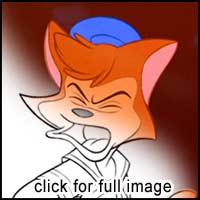
It's probably good at this point to outline the cleanup process. Cleanup is a detailed and laborious function, but nonetheless a recognized art form all by itself, as these are the final drawings the audience sees when viewing an animated project. And on "Cats," not only did the shapes unique to the characters have to move in a believable fashion, the thick-and-thin line also had to be consistent from drawing to drawing. (This thick-and-thin cleanup line isn't something that is incorporated into every hand-drawn animated feature, but something that is a unique artistic choice that ultimately contributes to the overall look of the film. Disney's "Aladdin" was another feature where a thick-and-thin cleanup line was employed.)
The cleanup and inbetweening process is really a constant operation of dividing and subdividing the rough animator's delineation of action until the scene has been refined and reidentified with a single, clean line. There are generally five steps in the process (in order, top to bottom): key assistant, assistant, breakdown, inbetween, and checking. The key assistant "sets the line" for the scene by laying down new sheets of paper over the animator's roughs and cleaning up the primary, or "key," poses in the scene: the ones that are the main indicators of the lines of action. There may be quite a few poses that fall into this category, so some that could be considered somewhat secondary might be earmarked by the key assistant for the assistant. The assistant then takes those rough drawings and, by laying down new sheets of paper on top of them and flipping them between the drawings the key assistant has made, continues to create new cleanup drawings, keeping the linework consistent.
The assistant then earmarks the rough drawings in the scene that are secondary to his or her drawings, and gives them to the breakdown artist. And so on down the line until the inbetweener has finished the rest of the drawings in the scene. (It should be noted that, depending on the animation studio, all of the inbetween drawings may or may not have been drawn by the rough animator, but rather charted in a fashion so that these brand new drawings are accomplished by simply laying down a cleanup line "in between" two existing cleanup lines.) The last step is accomplished when the whole scene comes back to the key assistant, who is ultimately responsible for the scene, and he or she calls out any possible inconsistencies in line or form by going through all the drawings either by hand or by having them filmed sequentially. This is the checking process.
In my mind, it's the key assistant's primary concern to make sure that all the poses that define the character's movement be paid specific attention to before the cleanup process even starts, and the only way to insure this is to continually study the animator's pencil test with all of the original drawings close by. On some scenes, the character's movement might be misconstrued or "flattened out" in the cleanup process. I've gone so far as to plot out sequential points of action (or "arcs") for various body parts on separate sheets of paper, so that the rest of the cleanup team on the scene would be able to see their importance to the overall flow of the character's movement.
Another important area of concern for the key assistant is making sure the character looks the way the directing animator wants it to. On Bob's or Jay's scenes, since they were the ones who ultimately defined Danny's look, this was not an issue. But on occasion, there were scenes by other animators that captured Danny's movements in a manner that was consistent with Jay and Bob's vision, but that didn't quite look like how Danny was really supposed to. So having to redefine Danny's look without changing the animation was important in keeping the illusion that he was drawn by one person. This is called putting the character "on model."
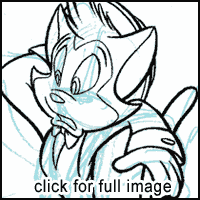 In scenes such as these, there might have been a really super-rough key movement drawing, or an element thereof, that I needed to put on model to make it faster and easier for the artists following me up in the cleanup process. This is an animator's drawing in a scene I was given that wasn't a key drawing. Due to the time constraints on the scene, I couldn't leave this one for an assistant, breakdown artist or inbetweener to figure out, but the drawing was definitely integral to the line of action. So I made a quick drawing on a separate piece of paper in different colored pencil, so they in turn could lay down a clean sheet of paper and "make it their own" by finishing off the drawing in black graphite.
In scenes such as these, there might have been a really super-rough key movement drawing, or an element thereof, that I needed to put on model to make it faster and easier for the artists following me up in the cleanup process. This is an animator's drawing in a scene I was given that wasn't a key drawing. Due to the time constraints on the scene, I couldn't leave this one for an assistant, breakdown artist or inbetweener to figure out, but the drawing was definitely integral to the line of action. So I made a quick drawing on a separate piece of paper in different colored pencil, so they in turn could lay down a clean sheet of paper and "make it their own" by finishing off the drawing in black graphite.
I found that the best way to insure my technique was correct was to do my own study in my spare time, using the model sheets Bob and Jay drew, and try to expand further on their construction methods. If I found something that might help the overall method of construction, I'd incorporate it into whatever scene I was working on and take it directly to them for approval.
Which scenes were your personal favorites to work on?
As far as scenes I enjoyed working on, there were two that immediately come to mind. Jay was animating the scene where Danny was teaching Pudge how to dance in an alley. I saw how much fun Jay was having, looking to film clips of the Nicholas Brothers for reference and trying out dance steps on his own, and creating this 180 degree change of emotion in Danny as he sees Pudge picking it up. I offhandedly mentioned while he was in the middle of animating it that I'd like to clean the scene up, and was more than a little shocked when this scene appeared on my desk one morning. It was this monstrosity of paper and graphite that, frankly, was pretty daunting! The scene took about a month to finish, as the acting/dancing was really complex. There are a few things about the scene that I wish I could have taken more time with, but like all things animated, you have to just let it go at some point. There were three top-notch cleanup artists following me up on this (Art Hernandez, Aaron Kirby and Mark Cote), and the scene wouldn't have been finished as well as it was without them.
The other scene was one that Steve Markowski animated, the one where Danny is racing across the rooftop of the Chinese Theater with Max's giant fist punching through the roof after him. This one was pretty complex too, as it was almost entirely on ones (meaning one drawing for every frame of film) and with some really difficult business going on. Since the rough drawings were 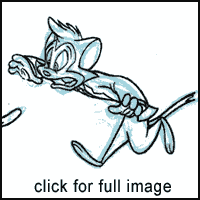 REALLY rough but mostly on model, I chose to do the majority of the cleanup myself. I really enjoy scenes like this where, with the rough animator's guidance and blessing, I can take it and put my own stamp on it. (It's much like the process was back in animation's first Golden Age, where the rough animator would hand their key drawings off to his or her assistant, who then did the majority of the drawing in the scene before sending it out for ink-and-paint.) There was obviously a lot of work to be done on this scene, and I remember a pretty tight deadline hanging over my head with it. I pulled an all-nighter to get it finished on time, went home at 6:00 the next morning, took a nap, and came back to the studio later in the day to get it approved. That situation might sound a little rough, but I found out early on that it's actually pretty common in this business. I find that under certain circumstances my best work gets done this way.
REALLY rough but mostly on model, I chose to do the majority of the cleanup myself. I really enjoy scenes like this where, with the rough animator's guidance and blessing, I can take it and put my own stamp on it. (It's much like the process was back in animation's first Golden Age, where the rough animator would hand their key drawings off to his or her assistant, who then did the majority of the drawing in the scene before sending it out for ink-and-paint.) There was obviously a lot of work to be done on this scene, and I remember a pretty tight deadline hanging over my head with it. I pulled an all-nighter to get it finished on time, went home at 6:00 the next morning, took a nap, and came back to the studio later in the day to get it approved. That situation might sound a little rough, but I found out early on that it's actually pretty common in this business. I find that under certain circumstances my best work gets done this way.
Putting aside deadlines, what did you enjoy most about working at Turner Features?
It's funny. I've been asked that question before, and every single time, words fail me. Almost everyone I know that worked on "CDD" feels the same way I do about what an absolute blast it was, but it's extremely hard for me personally to boil down my 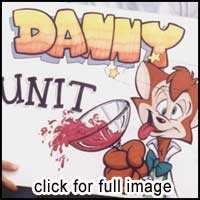 thoughts and emotions to a few sentences that describe exactly what made that particular experience so enjoyable. Maybe it was the combination of so many different personalities, and the creativity that each one brought to the mix. Perhaps it was all the "executive" things that might have conspired to sink the project that the crew had no control over, things that only made us hang together that much tighter to complete the film, and how that mirrored what the story of "CDD" was about. Possibly, the planets were aligned just so. For all I know, it could be all those things and much more. During the time it was happening, I never thought about why we were having so much fun, and in hindsight I still can't put my finger precisely on why this production just felt so...right.The only thing I know for certain: the reason why "Cats Don't Dance" continues to connect with audiences, despite its relative anonymity in the pantheon of animated features, is because we genuinely enjoyed each other's company and absolutely, unequivocally loved what we were doing. Those two things aren't manifested that often in any endeavor, and when they are, it's magic--plain and simple. Granted, the final output isn't to everyone's liking (that's fair enough), but there have been times when someone whose talent and opinion I respect finds out I worked on it and there's almost this hushed, wide-eyed reverence, like, "You were a part of that? Wow...."
thoughts and emotions to a few sentences that describe exactly what made that particular experience so enjoyable. Maybe it was the combination of so many different personalities, and the creativity that each one brought to the mix. Perhaps it was all the "executive" things that might have conspired to sink the project that the crew had no control over, things that only made us hang together that much tighter to complete the film, and how that mirrored what the story of "CDD" was about. Possibly, the planets were aligned just so. For all I know, it could be all those things and much more. During the time it was happening, I never thought about why we were having so much fun, and in hindsight I still can't put my finger precisely on why this production just felt so...right.The only thing I know for certain: the reason why "Cats Don't Dance" continues to connect with audiences, despite its relative anonymity in the pantheon of animated features, is because we genuinely enjoyed each other's company and absolutely, unequivocally loved what we were doing. Those two things aren't manifested that often in any endeavor, and when they are, it's magic--plain and simple. Granted, the final output isn't to everyone's liking (that's fair enough), but there have been times when someone whose talent and opinion I respect finds out I worked on it and there's almost this hushed, wide-eyed reverence, like, "You were a part of that? Wow...."
And all I can do is smile. The little fire inside me that I felt while I was working on the film gets stoked once again, and it makes me walk a little taller knowing that I was an element of a moment in time that can't be explained so easily. Call it kismet.
What productions have you worked on since, and what are you currently working on now – if you are allowed to tell?
Right after "Cats Don't Dance," I was fortunate enough to be one of the first American cleanup artists hired into the core group that helped get DreamWorks Animation on its feet. I worked on "The Prince of Egypt," "The Road to El Dorado," and "Spirit: Stallion of the Cimarron" for them. I was constantly blown away by the work of the artists that came over here and who had formerly made up Steven Spielberg's Amblimation Studios in London, and still consider "The Prince of Egypt" to be one of the artistic high points of my career. And on "El Dorado," I got to work with Rodolphe Guenedon on the character of "Chel." Rodolphe is, in my opinion, one of the top ten animators currently in existence; the way he works seems so effortless, and the output so beautiful that you wonder if he might be alien. The fact is he's one of the most intelligent, down-to-earth humans I've ever met, and he loves his wife and family with a passion like I've never seen.
After that, I worked on "The Wild Thornberrys Movie," which as Frans noted in your interview with him, turned out better than anyone expected it to! I also worked on "Looney Tunes: Back in Action" with legendary animator and director Eric Goldberg and a crew of top-flight ex-Disney artists, most of whom had been recently laid off after Disney shut down their hand-drawn animation feature unit. (It was around this time that my focus shifted to learning how to actually animate, instead of creating the finished cleaned-up drawings based on the animator's work.) From that experience I was blessed to be able to work directly with Eric, animating and cleaning up on a number of his personal projects, including two installations for theme parks: "Gran Fiesta Tour starring The Three Caballeros" (for the Mexican Pavilion at EPCOT) and "A Monkey's Tale" (for Ngong Ping Village Attraction in Hong Kong). I also worked on "Curious George" as a rough inbetweener (an apprenticing rough animator position) under Tony DeRosa, a well-respected Disney veteran, who was the supervising animator on "George."
I worked for almost a year on "The Simpsons Movie" as a cleanup artist and model and prop designer, and recently wrapped as a rough inbetweener on Disney's "The Princess and the Frog," in their long-overdue return to hand-drawn animation features. That was a lot of work, more than I ever anticipated, but I loved every single second of it. There are a lot of high expectations for this film, and I have a feeling it won't disappoint.
Do you have any non studio related projects going on?
No, and unfortunate as it might seem to some, I'm really kind of mundane in that regard. I'm not the sort of artist that does a lot of things that are just outside of the production norm, like storybooks or sketchbooks or self-produced shorts. If I'm not doing overtime on a project or spending a little extra time training myself, like doing little animation tests or learning how to animate better on the computer, I tend to try and live my life as fully as possible. I found very early on in my career that if I don't have a fair amount of time to myself outside of work, I get really stressed out and have a horrible time sleeping! In that vein, I've read numerous quotes from artists of all disciplines that the experience of life itself is more beneficial to learning and perfecting the artistic process than anything else. I absolutely love people-watching, and find studying human beings and their personalities to be very relaxing, not to mention informative to the animation process. I could spend hours in an airport or shopping mall just sitting in one place watching people. I file stuff away in my memory or write it down, and pull it out if or when I need to have something for a character to do. I also like watching movies or television as a way to study movement and character, and I'll sometimes frame-by-frame things both live-action and animated as a method of study. I've always been fascinated by that sort of thing, and I love Eadweard Muybridge's work. I could look at books of his work for long stretches of time and never get bored.
And there are always things that need fixing around the house, most of which I actually enjoy doing. About ten years ago, the yard at my old house needed relandscaping. As a result, I got bitten hard by the "gardening bug" and discovered that it was the perfect antidote to forgetting about the everyday stresses of the animation process, as well as simply being another outlet for creativity. After spending an abundance of my time attempting to be so exact for a living (helping to handcraft film one frame at a time), working with plants in my spare time teaches me not to be so much. In the garden I can make everything just so, and the next day there'll be something different about it, something I might have absolutely no control over. I find too that the subconscious headspace that artists enter into as they're creating is much easier to get into while I'm out there digging in the dirt. I also like how it informs virtually every other facet of my life. I won't say I'm an expert at it--I've killed more plants due to neglect or stupidity than I'd care to admit--but there's something I find about working outside and being able to recognize the thread that connects all living things on this planet to be extremely calming on a zen-like level.
One of the biggest tasks I have ahead of me these days is updating my website, which can be seen at www.toddjacobsen.com . I think it's time to see if I can shake things up a little bit by going back into my graphic design training and rearranging my work a little differently. Maybe try taking out some old stuff, and adding some new things.
- Todd Jacobsen
Click the banner to see more of Todd’s clean up work on ‘Cats Don’t Dance’ and be sure to check out the rest of his portfolio to see his animations, storyboards, and designs for other feature films.